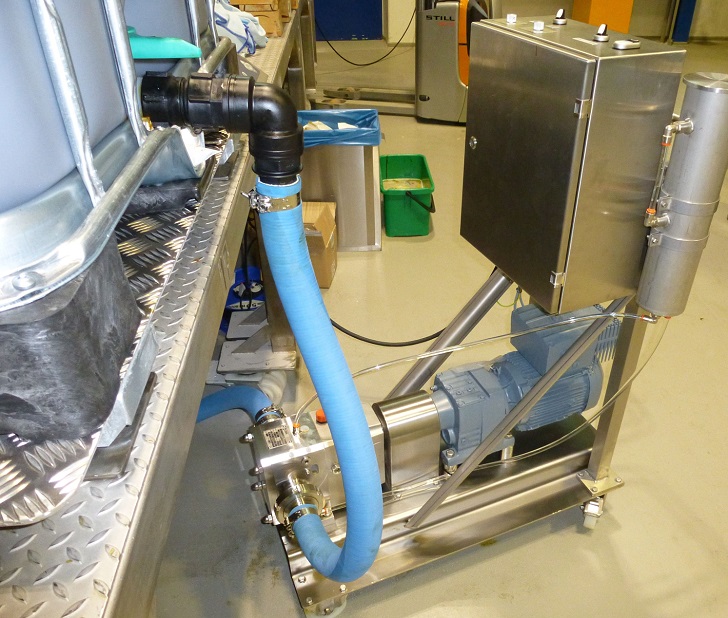


Many food substances require particularly gentle preprocessing and precise further processing according to recipe specifications in order to ensure uniform product quality. Here, we see how a mobile rotary lobe pump enables exact metering in the molasses mixing process.
Production of a wide variety of foodstuffs often requires a base mass as an emulsifier. This is a mix of phospholipids, which are composed of fatty acids, glycerine, phosphoric acid and choline. Lecithins are components of various fats and oils and are particularly abundant in egg yolks and cells of plant seeds such as in rapeseed, sunflowers and soy. These substances require gentle preprocessing and precise further processing to ensure uniform product quality.
To guarantee this at a flow rate of approximately 200 kg in the shortest possible time while maintaining a high degree of viscosity for the molasses, the Hamburg-based company Terheggen & Dethlefsen - Food Engineering GmbH decided to purchase a corresponding unit for the new application on its premises. After extensive on-site consulting from the experts of LEWA GmbH, the company chose a Pomac PLP2-2.5 rotary lobe pump; Hansa Industrie-Mixer GmbH & Co.KG provided the matching control system for the system. "When conveying, processing and metering substances specifically in the food and delicacies industry, accuracy, hygiene and speed are required above all else," explains Heinz Woldering, area sales manager at LEWA. "Depending on the degree of viscosity of the liquid medium to be conveyed, this task can be difficult, and many conventional pumps fail to meet the high operating requirements."
High-viscosity At Terheggen & Dethlefsen, the high-viscosity base molasses has to be added to the product from an intermediate bulk container (IBC) during the mixing process in accordance with the recipe specifications.
After the local conditions were viewed, a rotary lobe pump of the type Pomac PLP2-2.5 was used on Woldering's recommendation. This pump is characterized particularly by its speed reliability, low noise level and high metering accuracy even when the medium being conveyed has a very high degree of viscosity.
"The pump version used at Terheggen & Dethlefsen is a stainless steel design that satisfies the strict criteria of the EHEDG," says Woldering, elaborating on the pump's advantages. "The modular design of the Pomac line and the various options with respect to the installed seals and connections enable a high degree of flexibility for the installation and implementation of special customer requests."
New pump station At Terheggen & Dethlefsen, the new pump station was specially adapted for the medium to be conveyed and was thoroughly tested to verify its suitability for the application. The lecithin molasses made gentle feeding into the mixing process absolutely necessary in order to guarantee uniform product quality.
In addition, the high viscosity of the molasses and the associated shear stress had to be considered when the pump was selected and dimensioned. In view of all the components, LEWA recommended using a Pomac PLP2-2.5 with bi-wing rotors.
Type PLP2-2.5 is designed so that it is possible to have a delivery rate of 36 l / 100 revolutions at a maximum speed of 1000 rpm, which satisfies the quality requirements particularly with respect to conveying the molasses in a way that does not harm the product.
"The prevailing pressure of 2-5 bar during this process was not particularly challenging for the PLP 2-2.5, because the pump is designed for a pressure of up to 15 bar," Woldering adds. "From our side, the pump was also equipped with a gear motor with an integrated frequency inverter and then delivered to Hansa Industrie-Mixer for further processing."
Dry running prevention To prevent damage to the system from dry running and the resulting production downtime as well as time-consuming repair work, a special dry-run protector was built into the new pump in the form of a double mechanical seal. Pumps of the Pomac series have the advantage of five different seals, from which the one that is right for the respective application can be selected. The material can also be adjusted to satisfy specific customer requirements. A double mechanical seal was installed at Terheggen & Dethlefsen.
"A confining fluid is supplied to the seal using a thermosiphon tank so that damage caused by dry running can never occur," Woldering elaborates. "The seals consist of FDA- and EC1935/2004-compliant elastomers made of Viton.
They are particularly suitable for food production because they exhibit very high thermal and chemical resistance." All five variants of the shaft seal used for the PLP standard series are accessible from the front in accordance with the "front-pull-out principle" and are interchangeable—meaning that maintenance and repair tasks can be carried out quickly and easily.
Customer-specific control The special requirements of Terheggen & Dethlefsen also necessitated additional features. "A mobile metering system was required that automatically admixes certain quantities of the medium being conveyed in accordance with the control signals of a scale," Woldering explains. LEWA delivered the pump, including the frame and cart, and brought Hansa Industrie-Mixer GmbH & Co. KG on board.
Hansa Industrie-Mixer has many years of experience in the food industry and was responsible for designing the control system, manufacturing a suitable stainless-steel control cabinet and implementing suitable components such as hoses and check valves.
The separate control system was necessary to ensure accurate metering in accordance with the recipe and to make sure the mixing process runs smoothly in automatic mode. "LEWA approached us with the request to develop a control system that acts as a connection between the scale and pump and then to test it right in the Terheggen & Dethlefsen plant," states Hans-Georg Frenzel, Technical Manager at Hansa.
"Our application-specific control cabinet now contains the power supply including the cable with plug and terminal strip, a bus interface for connecting to the weighing terminal as well as a user interface with buttons, switches and two potentiometers for the pump speed: one during rough metering and the other during precision metering." A switch was also integrated to enable the selection of manual or automatic mode.
High-precision A high-precision scale adapted specifically for this application was used for metering; it was connected to the control system and then to the pump. The scale is used to define the precise amount of molasses in accordance with recipe specifications. The exact quantity specifications are stored in the weighing terminal and are forwarded from there to the pump's control system.
Frenzel says, "The metering itself is controlled by signals. After two test runs and thanks to good collaboration of the entire project team, we were then able to modify and configure the system so that all of Terheggen & Dethlefsen's requirements for delivery rate and process speed were met."




